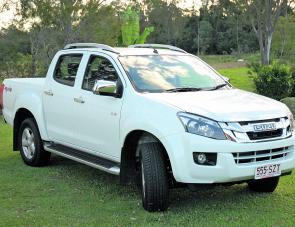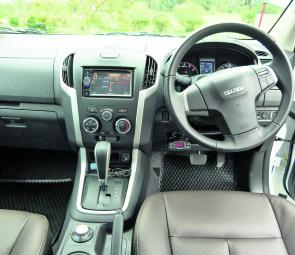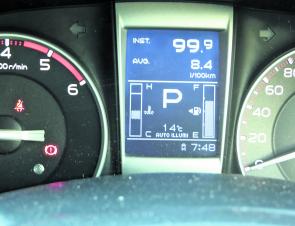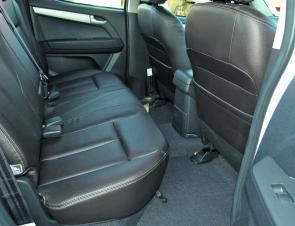Since the release of the latest series D-Max a few years ago, Isuzu Ute Australia has progressively released new models to take on the opposition, which is pretty fierce when we consider the market niche.
Twin cabs such as the Nissan Navara, Holden Colorado, Toyota Hilux, Mitsubishi Triton, Mazda BT50, Ford Ranger, and VW Amarok all offer different levels of comfort and features and, of course, price points to suit.
The Isuzu D-Max LS-Terrain is about as close to all-bells-and-whistles as Isuzu currently offers and as such, comes with quite a bit of fruit. The basic D-Max plate offers coils/ gas shockers suspension up front, springs and gas shocks at the rear, a well proven 3L diesel under the bonnet, room for two up front and three more in the rear, all seated in quite comfortable surrounds.
While a long way from a luxury vehicle, the LS -Terrain D-Max has sufficient goodies to see it fairly regarded as a class leader a couple of years back. But with things always moving onwards in the world of twin-cab 4WD utes, today’s D-Max can best be regarded as quite good value but not a game changer.
Nonetheless, it did take out the coveted Ute of the Year in Austalian Four Wheel Drive Action magazine, so there’s more to the package than meets the eye.
It wasn’t hard to identify some very good features about the LS-Terrain D-Max five-speed auto reviewed model.
There’s one-touch window adjustment, pollen-filtered air conditioning, leather-trimmed seats and steering wheel power-adjustable driver’s seat, ample storage and drink holders.
The D-Max’s rear split-fold seats even have reclining backrests.
Cruise control was a simple, one-touch on/off located on the steering wheel.
There was also a lot of head and leg room for front and rear passengers, which was important; one trip with the D-Max involved a four-person run from Brisbane to Bundaberg towing a loaded box trailer.
The D-Max has a towing capacity of some 3 tonnes for a braked trailer, 750kg unbraked and a total load capacity of 1015kg.
The LS-Terrain also features a decent sound system with a CD/MP3/AM/FM audio unit and has Bluetooth interface.
A large central touch screen offers a host of features from fuel consumption (present and projected range) plus an easy-to-use GPS navigation system and a very good reversing camera.
The exterior of the D-Max LS-Terrain is also up-market.
Up top were 60kg capacity roof rails and down below, 17” alloy wheels dressed up the rubber.
Strong side steps protected the side body panels from sticks and the like when travelling off road, and the full-sized spare wheel sat under the rear.
Unlike some competitors, under-body protection was a real strength of the D-max as every vital item under the vehicle was protected by a steel plate.
On the highway the D-Max impressed with its easy, loping power, courtesy of the 3L four-cylinder, intercooled turbo diesel. A seamlessly changing five-speed auto (with Tiptronic for those who like to select gears manually) handled the diesel’s 130kW of power and 380Nm of torque.
These are somewhat modest figures compared with output of the likes of the five-cylinder Mazda BT50/Ford Ranger but in the context of the sheer ease of driving, powerful acceleration and ease of highway overtaking, the D-Max can certainly hold its own.
The Isuzu was great to drive on the open road. Ride was excellent, steering easy and quite exact with no excessive body roll or oversteer tendencies. With four aboard and the trailer on the towbar, the vehicle rode more like a sedan than a work ute.
The D-Max LS-Terrain has a suspension biased towards comfort, no question about it. Up front there are independent coils and gas shocks linked to double wishbones and stabiliser bars while at the rear, under the double-lined cargo area, sat what Isuzu refers to as a High Ride suspension of overslung semi-elliptic leaf springs and gas shocks.
With this rear suspension there’s not likely to be much bouncing from the tray on virtually any bitumen surface, with only quite bad unsealed roads causing some bumps and thumps to be felt as suspension rebounds, and possibly even some bump steer coming into the mix.
The D-Max features hill ascent and descent control, emergency brake assist, electronic stability control, traction control and a host of air bags to protect occupants.
The D-Max in any 4WD guise is an excellent off-road performer and the LS-Terrain is right up to the mark. Ground clearance is more than adequate and front and rear overhang are not likely to cause many issues. The 4WD system engages on the fly up to 100kmh via the console dash.
Low-range gearing keeps the rubber turning where roads or tracks end and I’d see virtually any beach work or bush tracks along rivers well within the capability of the D-Max.
Around some of our boat ramps that 4WD capability would be earning its keep as well.
At $51,700 drive-away, the top of range D-Max LS-Terrain won’t be as expensive as some competitors but offers good road manners and has definite capability for work and play options.
It’s an honest, reliable, sort of vehicle with a big heart under the well-shaped bonnet. Fuel consumption is frugal, with 8.4L to 9.2L per 100km achieved during the Bundaberg journey. Tank capacity is 76L so a useful touring range is assured.
Reads: 2341
Easy on the eye, easy on the pocket to run, that’s the D-Max LS-Terrain.

There’s plenty of tray room and comfortable seating for four or more.

Off the road the LS-Terrain can certainly hold its own, thanks to ample ground clearance and 4WD shift on the fly.

The Isuzu’s dash layout involves a fair amount of hard plastic but gauges are easy to read, controls for various items easy to identify, and the leather-trim seating adds a touch of luxury.

Frugal fuel consumption always will be a strong point of the D-Max diesel.

With this amount of head and leg room, rear seat passengers in the LS-Terrain are not likely to be cramped.

The large, user-friendly touch screen with GPS and reversing camera is a handy item.




